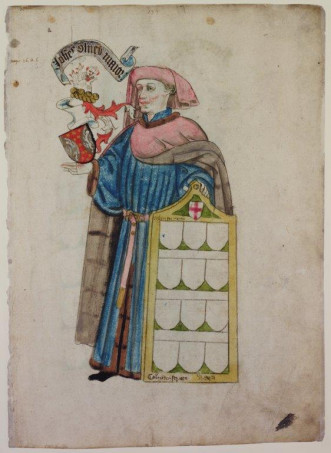Final reminder, the Brook Rural Museum Medieval Fayre is this Saturday between 10am and 3pm – as well as the stunning barn and its collection, there will be a wide range of demonstrations and other activities: https://brookruralmuseum.org.uk/ . Although in other ways this week is quieter, there are further events coming up in July that I want to flag up as well as reporting on Dr Janet Clayton’s presentation yesterday. Moreover, Dr Astrid Stilma has volunteered to provide a blog later this week on the Aphra Behn conference, with special emphasis on the dramatic performances that CCCU funded. Consequently, I’m going to keep this one shorter than usual.
In order, firstly Kieron Hoyle will be speaking at Dover Museum on Thursday 18 July at 7.30pm. The title of her talk is ‘The Maison Dieu and Dover’ where she will explore the fascinating and turbulent history of the Maison Dieu in the 16th century, especially the building’s many lives from pilgrim hospital and store house to a victualling yard for the Royal Navy. This free talk can be booked at: https://bookwhen.com/maison-dieu/e/ev-s0ug-20240718193000
Secondly, Dr Heidi Stoner (Senior Lecturer in Early Medieval Archaeology, CCCU), as part of the CBA Festival of Archaeology at Canterbury Cathedral will be giving a talk in the Cathedral Archives on Thursday 25 July at 6.30pm. Her talk is on ‘Finding Vikings’ and she will be discussing recent discoveries and ideas in Viking Studies and how these have the potential to aid the ways researchers can approach studying Vikings in Kent. Tickets are £5 and pre-booking is required at https://www.canterbury-cathedral.org/events
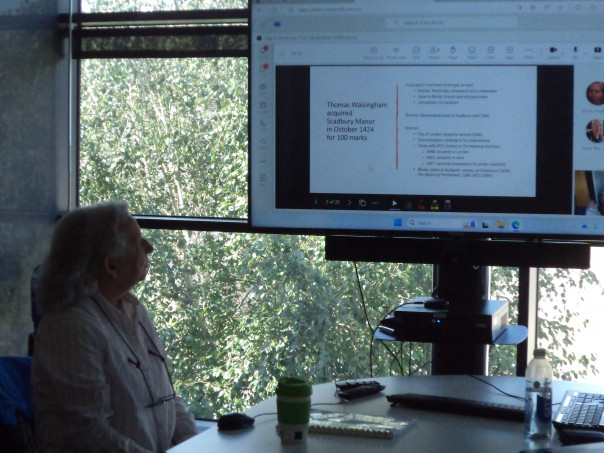
Now to the last of the Kent History Postgraduates group presentations for 2023-24 and our speaker was Janet, who has revisited a topic she did several years ago but which has now come back into the foreground because of recent archaeological discoveries at Scadbury. Thomas Walsingham, the first of that name to hold Scadbury was a highly successful London merchant and royal servant, as much at ease around the court at Westminster as he was in London’s Guildhall or the port of London where he operated first as an importer of wine from France and, as his career progressed, he traded in a range of goods including the export of wool. As a contemporary, more or less of Richard Whittington, he shared such literary interests, and among the possessions mentioned in his will of 1457 are several books and his book cupboard.
When Janet started on her research relatively little was known about him, the historiography primarily comprising a History of Chislehurst published in 1899 and the entry in the History of Parliament series because he had been a Member of Parliament, although interestingly not for London but the West Country, perhaps linked to his trading connections. Nevertheless, Janet was able to extend this considerably using a wide range of sources, some of which have only recently become better known. So with this as her background, Janet began by discussing Thomas’ parentage.
Alan Walsingham was a cordwainer who dealt in white leather and Juliana his mother, too, was from an East Anglian family being a Massingham. Alan was successful and as well as being a master cordwainer, becoming master of the company in 1383, twelve years later he acquired an inn called the Tabard of the Hoop where he would have brewed as well as sold beverages and perhaps an adjoining tenement called Le Forge. These properties were in the parish of St Benet’s Gracechurch and therefore slightly to the north of London bridge.
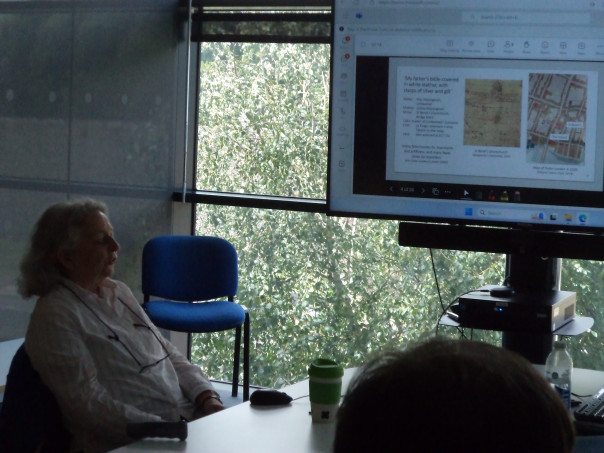
Young Thomas as a member of the vintner’s company was soon supplying wine to Richard II, which meant he was working closely with the king’s butler Gregory Ballard, a connection that would be important to both men and to their offspring. Moreover, this success meant that in 1398 he was in a position to lease a property in Cornhill with his father called le Grenegate. Thomas was able to ride the storm of the change of monarch and he was on good terms with Henry IV’s new butler, John Payn, while Ballard joined the household of the archbishop of Canterbury. Continuing to prosper, Thomas was on good terms with Thomas Chaucer, another royal servant which took him into the orbit of the Beauforts, as well gaining a royal appointment as Gauger of Wine at the Cinque Ports in 1404 and three years later the king granted him the lease of Le Grenegate for life.
Then in the 1420s he was twice appointed as Collector of Tunnage and Poundage at the Wharf of London, the second time as Beaufort’s nominee, such positions meaning that when he was elected as alderman of London for Castle Baynard Ward, he was discharge from service just three months later because he was so active on the king’s business. As Janet said, a measure of his worth and stature can be gauged because as part of this deal he agreed to glaze the eastern window of the Guildhall that was in the process of being refurbished, which would have been a considerable undertaking.
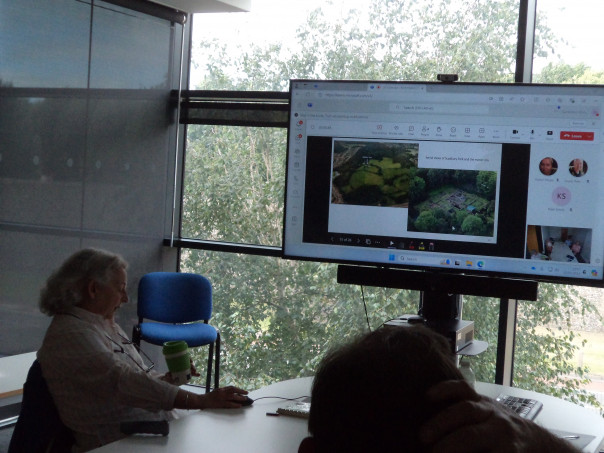
In terms of his own family, Thomas married a wealthy widow of one of his fellow vintners about 1413, seemingly soon after his father’s death. Margaret was also an heiress being the daughter and niece to two important goldsmiths, Henry Bamme and Adam Bamme. Moreover, Thomas seemingly remained on very good terms with his wife’s family, Adam’s son was one of his executors, who was heir to the manor of Grange, a Thames port and member of the Cinque Ports. Thomas and Margaret had two children, a daughter and a son.
The Beaufort patronage was of considerable benefit to Thomas, for he supplied wine to Henry Beaufort and exported his wool, as well as providing financial and administrative services. In addition, this association with the great bishop of Winchester was also on a personal level because amongst Thomas’ possessions was a ‘great Bible … that my Lord Cardinal gave me’. Moreover, as Janet said, it is worth remembering the Cardinal’s links to Christ Church Priory for in return for providing the monks with the manor of Bekesbourne, the Cardinal had a lavish residence built in Canterbury Cathedral precincts, albeit he barely lived long enough to really enjoy the innovative comforts of Meister Omers. Thomas, therefore, was not only extremely wealthy and in high standing with the Lancastrian royal dynasty but was in a position to act as a host and do business with two of the great Italian merchant families who were operating in London in the 1440s.
Janet next discussed his relationship with St Katharine’s-by-the Tower and the adjacent St Katharine’s hospital where he seems to have worshiped and was where his wife was buried. In this later stage of his life he may have been a corrodian at the hospital having received the lease of a property there, and when he died he wanted to be buried next to Margaret in the chancel of St Katharine’s. Janet also noted that we know a little bit about this property because he mentioned that it had a garden in his will, and much of the household stuff was to go to his son.
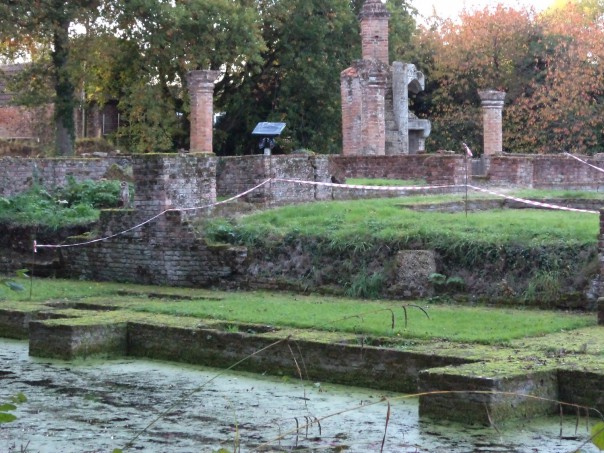
Like other London merchants, he acquired property outside of London, in this case Scadbury manor in Kent having paid 100 marks in 1424. It is this that first drew Janet’s interest and archaeological work there has revealed and continues to reveal some tantalising glimpses concerning what the manor house may have been like in Thomas’ time. Furthermore, Scadbury may originally have been a 13th-century moated manor house with outbuildings and fishponds. Thinking about this further, Janet offered some thoughts about what it might have been like in Thomas’ time, such as possibly a flint-built stone ground floor with timber framing above. Also are we looking at an open hall, not as grand as Penshurst, but still with an open hearth in the centre? This might be expected except that recently there have been tantalising new finds which the experts believe are pieces from a fireplace dated to c. 1430. Other finds include floor tiles with green glaze and while slip, as well as quantities of roof tile, and some pieces from household objects. By bringing together Thomas’ three wills and especially the third with its detailing of his possessions, these archaeological finds and a few surviving pieces, Janet and her group have some idea about what Scadbury would have been like before the house was rebuilt in brick by Thomas’ son or grandson.
Bringing her excellent presentation to a conclusion, Janet considered the next generation in the form of Thomas’ son Thomas and Thomas Ballard, his contemporary and the son of Gregory. For Thomas Ballard and his wife Philippa give a great mazer with cover to All Souls College in Oxford in 1437. This piece still survives being these days in the Ashmolean Museum.
 Centre for Kent History and Heritage
Centre for Kent History and Heritage Sheila Sweetinburgh
Sheila Sweetinburgh 1586
1586